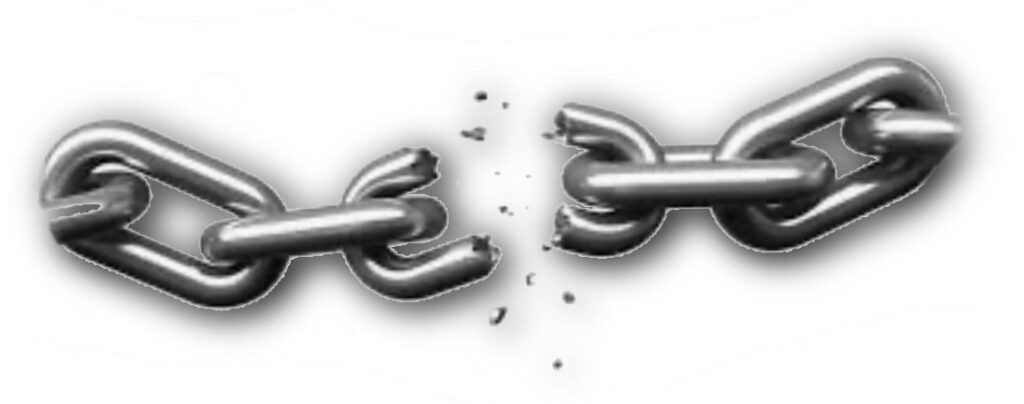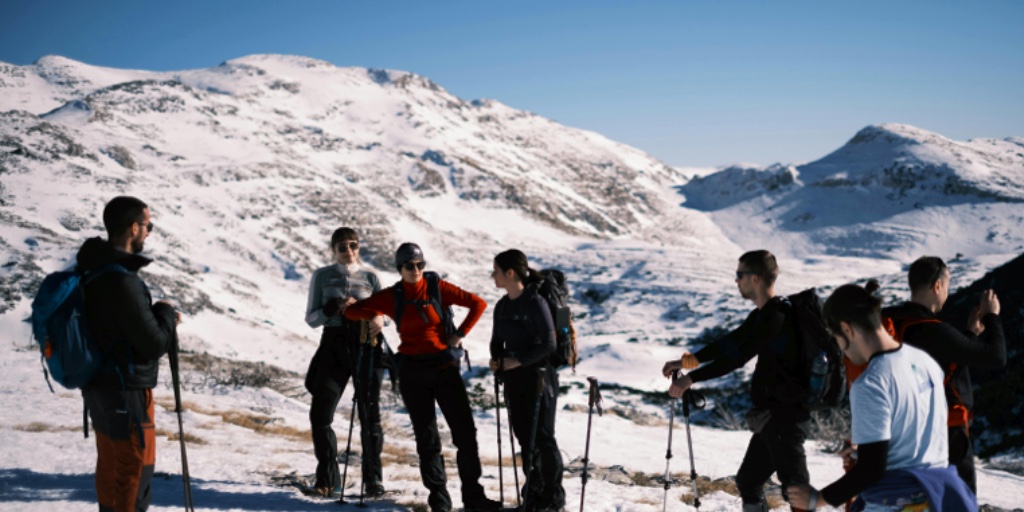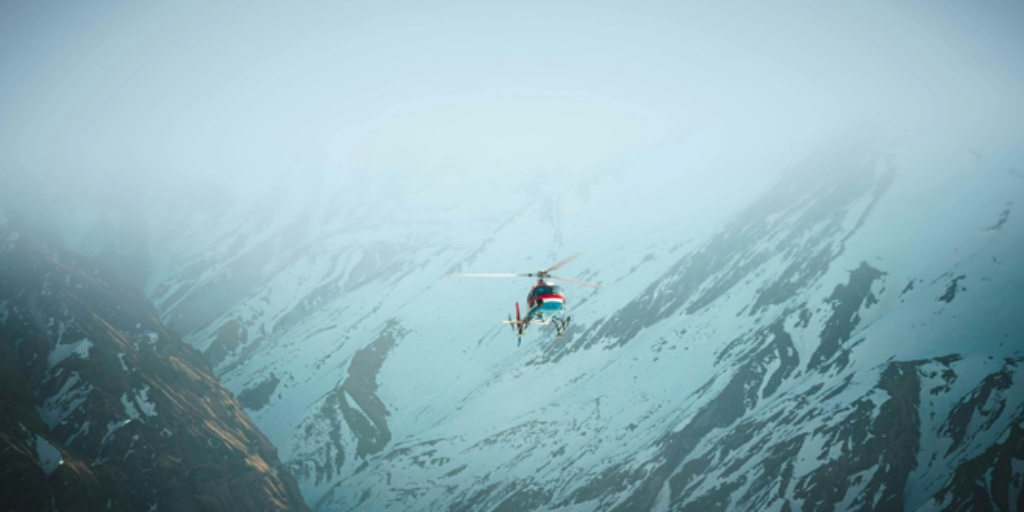 What follows is a true story, though the names have been omitted as that information doesn’t serve anyone — not that we even remember. The event happened many years ago and occurred on Mt Washington. We were guiding a paid group on the “winter route” of the Lion Head Trail. We had started out at the “boot/pack room” below the AMC’s Pinkham Notch Visitor Center at around 7:30am and we made the summit at around 12:30pm. It was a nice day all in all, at least for Mt Washington. Uneventful for the time being. According to the forecast, however, a major snowstorm was predicted to forcefully begin in the late afternoon.
What follows is a true story, though the names have been omitted as that information doesn’t serve anyone — not that we even remember. The event happened many years ago and occurred on Mt Washington. We were guiding a paid group on the “winter route” of the Lion Head Trail. We had started out at the “boot/pack room” below the AMC’s Pinkham Notch Visitor Center at around 7:30am and we made the summit at around 12:30pm. It was a nice day all in all, at least for Mt Washington. Uneventful for the time being. According to the forecast, however, a major snowstorm was predicted to forcefully begin in the late afternoon.
At the rate we were going we had plenty of time to avoid the chaos and associated dangers of a blizzard in the alpine. After a lengthy break at the summit, sheltered on the east side of the Sherman Adams building, we began our descent. This was at about 1:00pm. To the west there were clouds building but the eastern views were still pretty clear, there was very little wind at the moment, and the temperatures were warm enough to allow us to enjoy a leisurely mindset. It didn’t feel like a race; there was no real sense of urgency. We had a nice window in which to do our thing: get our guests below treeline, and ultimately to the parking lot and home.
If that was all that happened on the mountain that day, the situation that was about to unfold would have never occurred and there would be no story to tell aside from the proud tale of summiting the mountain. We would have never been involved with something we didn’t plan on being involved in and everyone would have had a happy day. Of course, here we are, telling this story so we know there’s going to be a twist.

Chapter One: Collegiate Climbers
We weren’t alone on the mountain. As is typical other guided groups were climbing their climb. Enjoying their day. Professional guides keeping their charges safe. There were also private groups, some skilled and unskilled individuals, and some out-of-staters enjoying a day on the tallest mountain in the northeast. One college group from somewhere, maybe New York, was doing the same and also enjoyed their time on the summit. But as hikers and climbers know, success is only a prize claimed when everyone is off the mountain. Of these collegiate climbers we would not even be aware if not for some of their critical errors in judgement.
We became aware of the group at the top of the “steeps” on the route we were on. There were four guys. That in and of itself was unremarkable until one of them asked us: “Is this the Lion Head Trail?” For the uninitiated, this information should be known with absolute certainty. Especially since as we learned they came up this way that morning. Coming up, however, they were just following their college leaders. They weren’t engaged in the process of navigating the mountain. Essentially, this was their first mistake. That job landing squarely on the shoulders of those in charge. Even when following someone in the know, everyone on the team should be at least somewhat engaged in this process.
Chapter Two: Compounded Errors
 We responded to this group of novice climbers affirmatively. Realizing they were like lambs in the pasture, susceptible to whatever predator was thrown at them, we invited them to use our ropes to aid their descent. Ideally they would have had their own ropes and known how to use them but they didn’t. At least these four individuals didn’t. We could say this was their second mistake. We slowed to a crawl but keeping them safe was worth it. We were below treeline so impending blizzard or not, we still didn’t feel rushed. And neither did our guests. They were, in fact, eager to help realizing just how important our efforts were to these young men.
We responded to this group of novice climbers affirmatively. Realizing they were like lambs in the pasture, susceptible to whatever predator was thrown at them, we invited them to use our ropes to aid their descent. Ideally they would have had their own ropes and known how to use them but they didn’t. At least these four individuals didn’t. We could say this was their second mistake. We slowed to a crawl but keeping them safe was worth it. We were below treeline so impending blizzard or not, we still didn’t feel rushed. And neither did our guests. They were, in fact, eager to help realizing just how important our efforts were to these young men.
During this time it was natural that conversation ensued. We learned that they were from a particular college and this was an annual outing for their Outdoor Club. We also learned that they started up the mountain as a group of 12. Within that group we learned that there were four “experienced leaders.” Upon summiting, we learned these four leaders began descending without the other eight students. This was their third mistake. They should have all stayed together with a couple of the leaders taking up the rear as sweeps to ensure no people or gear were left behind. At the very least they should have waited for their group at each and every junction. They didn’t, though, and this could be counted as their fourth mistake. All these errors in judgement were adding up. Soon there could be a steep price to pay.
The four leaders were well ahead of us, probably nearing the base of the mountain by the time we encountered the four who we helped. Surely they had no idea what was going on. They were probably elated and thinking about food and beers. If you’ve been keeping track of the numbers you know we’ve accounted for only eight people: The four leaders and the four whom we aided. This left four more still unaccounted for. As we learned about the circumstances, it became apparent that the other four were between the two groups. But where were they? We didn’t think they passed us so this was a real puzzle. If these four didn’t know where they were it’s likely the unaccounted for middle group also lacked this knowledge. Inasmuch we were starting to worry that they might have taken a wrong turn. Our suspicion, as we later learned, was fact. The four leaders were well ahead of us, and four of their charges were with us. The middle four had seemingly gotten confused and took a left starting their way across the Alpine Garden. For those who know this area, you know this is serious. Especially with a major snowstorm inbound.
As we were guiding and now taking on four more people, we couldn’t really break away to start scouring the mountain ourselves. This would have been our mistake. Fortunately we were experienced enough to know this. We did report it, however. But no action was going to be taken. With a snowstorm coming in and knowing the exposed expanse of the mountain’s alpine areas — assuming this is even where they wandered off to — this would be like searching for a needle in a haystack. While Search and Rescue (SAR) teams do tolerate many risks, they are not going to trade the lives of their team. While “up there” we are all on the same team, but we all have our limits, though. SAR always has to weigh the risks and sometimes this results in some painful but often necessary decision making.

Chapter Three: In Need of Rescue
Three-quarters of the way across the Alpine Garden four youths stumbled along the snow-covered expanse unsure of exactly where they were or where they were going. They were starting to suspect they might have taken a wrong turn but they didn’t have a map, a compass, or the knowledge to put these tools to use if they did have them, (their fifth mistake), and their leaders were long gone, unaware of the events unfolding. The weather was changing, the snow was starting to swirl, the winds were picking up, and the temperatures were plummeting. To this group they were realizing that they might be in over their heads. They decided they needed to seek shelter, fast.
They were closer to the mountain’s “cone” and there were some larger boulders that might serve as a shelter. They found a suitable space and crawled in. In doing so someone looking for them would have never found them. But what choice did they have? What had begun as a life-changing adventure was clearly turning into a life-challenging catastrophe.
Thankfully one of this fateful crew had a personal locator beacon (PLB), pulled the device from his pack, and pressed the “Help” button. In doing so an alert was transmitted by way of a constellation of satellites to the authorities and, ultimately, the Mountain Rescue Service (MRS). Also contained within the packet of data were their team’s coordinates. In other words, they could be located. Thanks to having this critical information MRS would be given the green light to pluck the youths from their in-place shelter. Without their location, the effort would have had to wait until the storm was over. As it was, threading the needle, racing the storm, was still a risk.
The team was found, though, huddled tightly together, spooning one another to stay as warm as possible, all but one still in reasonably good condition. The fourth was in rough shape, gripped in the clutches of hypothermia, but in the end his life was saved. Without that ever-important location information it is quite likely the after-storm mission would have almost assuredly resulted in a recovery instead of a rescue. Thanks goes to MRS and the technology used to make possible their efforts.
Chapter Four: Lessons Learned
 So looking back, there were some important takeaways from this scenario everyone should take note of.
So looking back, there were some important takeaways from this scenario everyone should take note of.
- Lesson 1: While having an experienced leader is very important, those who follow must stay engaged.
- Lesson 2: Have an understanding of how to manage oneself and have the appropriate tools at the ready.
- Lesson 3: Stay together, especially in a situation like this one where leaders and followers separated.
- Lesson 4: Always re-gather at each and every trail junction. This is often where the tides turn.
- Lesson 5: Know the route, carry navigational tools, and know how to use these important items.
- Lesson 6: It’s wise for people to carry some sort of PLB-like device, especially in the fall, winter, and spring.
With these lessons, one can graduate from the mountain.
![]()
Photos by Pexels.
